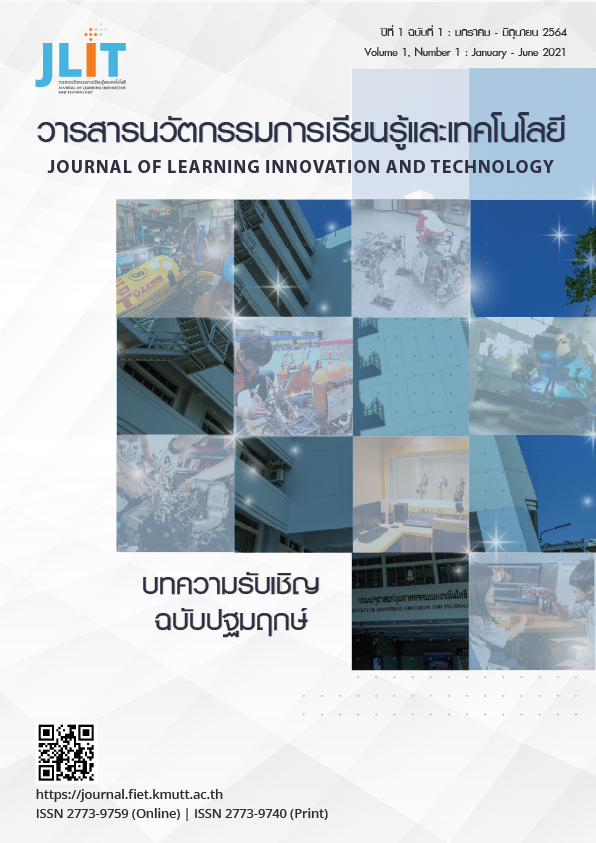การลดความสูญเสียในกระบวนการผลิตและจัดการสินค้าในโรงงานสัตว์ปีก
คำสำคัญ:
การวางแผนการผลิต, การพยากรณ์, สัตว์ปีก, การจัดเก็บสินค้าในคลังสินค้าบทคัดย่อ
งานวิจัยนี้มีวัตถุประสงค์เพื่อพยากรณ์ปริมาณความต้องการอาหารสัตว์ปีกจำแนกตามช่วงวัยที่เหมาะสมของสัญญาฟาร์มประกัน (Contract farming) และลูกค้าทั่วไป และใช้เป็นข้อมูลสำหรับการวางแผนการผลิตซึ่งจะช่วงลดการผลิตที่เกินจำเป็น ลดการใช้ทรัพยากรการผลิตที่เกินความต้องการและที่สำคัญลดการจัดเก็บที่มากเกินไป อีกทั้งเป็นข้อมูลนำเข้า (Input data) สำหรับการจำลองการปรับเปลี่ยนรูปแบบการจัดสินค้าของบริษัทจากการบรรจุถุง (Bag) เป็นแบบถังพักอาหารสำหรับการรอบรรจุ (Bulk) ด้วยตัวแบบการถดถอยเชิงเส้นพหุคูณ (Multiple Linear Regression) โดยที่ข้อมูลที่ใช้ในการศึกษาเป็นข้อมูลของฟาร์มสัญญาประกัน จำนวน 31 เล้า รวมทั้งสิ้น 1264 ระเบียน ผลการศึกษาพบว่า ปริมาณความต้องการอาหาร (y) (หน่วย: กิโลกรัม) ขึ้นกับจำนวน (x1) (หน่วย: ตัว) และอายุ (x2) (หน่วย: วัน) ของสัตว์ปีกในแต่ละเล้าของแต่ละฟาร์ม ตลอดช่วงเวลาของอายุของสัตว์ปีก 0 – 40 วัน และเปอร์เซ็นต์การเลี้ยงรอดของแต่ละฟาร์ม ดังนั้น สมการถดถอยเชิงเส้นพหุคูณที่ใช้ในการพยากรณ์ มีดังนี้ อาหารสูตร 1 ได้แก่ yijkl = 0.05x1ijkl + 54.77x2ijkl – 393.29 สำหรับสัตว์ปีกอายุ 0 – 15 วัน (0<i<=15) อาหารสูตร 2 ได้แก่ yijkl = 0.11x1ijkl + 57.25x2ijkl – 1045.62 สำหรับสัตว์ปีกอายุ 16 – 30 วัน (15<i<=30) และ อาหารสูตร 3 ได้แก่ yijkl = 0.19x1ijkl – 65.64x2ijkl + 2132.13 สำหรับสัตว์ปีกอายุ 31 – 40 วัน (30<i<=40) โดยมีค่าสัมประสิทธิ์การตัดสินใจ (Coefficient of Determination: R2) เท่ากับ 0.732, 0.733 และ 0.351 ตามลำดับ โดยที่ i แทนอายุของสัตว์ปีก 1, 2, …, 40, j แทนฟาร์มประกันที่ 1, 2, …, X, k แทนเล้าที่ 1, 2, …, nj และ l แทนวันที่ผลิตอาหาร 1, 2, …, 365 นอกจากนี้ค่าความคลาดเคลื่อนที่ได้จากการวางแผนการผลิตลดลงแผนการผลิตที่บริษัทใช้ในปัจจุบัน โดยเฉลี่ย 5 เปอร์เซ็นต์ หลังจากที่เราได้ปริมาณอาหารที่จะผลิตที่ได้จากการพยากรณ์ เราจะนำไปใส่ในโปรแกรมการจำลองสถานการณ์อารีน่า ซึ่งมีการตรวจสอบความถูกต้องเรียบร้อยแล้วและมีความคลาดเคลื่อนเฉลี่ย 1.285% เพื่อหาจำนวนถังพักอาหารที่เหมาะสมต่อปริมาณการผลิต ได้ผลการศึกษาว่าพื้นที่ในการจัดเก็บสินค้าสำรองในคลังสินค้าจะลดลงเหลือ 127.4 ตารางเมตรจาก 2821 ตารางเมตรแตกต่างจากปัจจุบัน 95% ใช้พนักงานทั้งหมดลดลงเหลือ 10 คนจาก 19 คนแตกต่างจากปัจจุบัน 47% ใช้รถยกลดลงเหลือ 2 คันจาก 5 คันแตกต่างจากปัจจุบัน 60%
เอกสารอ้างอิง
Andreas M. Radke , Tullio Tolio , Mitchell M. Tseng, Marcello Urgo, “A risk management-based of inventory allocations for make-to-order production”CIRP Annals - Manufacturing Technology, V.62 (2013) 459–462.
Sanjoy Kumar Paul, Ruhul Sarker, Daryl Essam, “A disruption recovery plan in a three-stage Production - inventory system” Computers & Operations Research, V. 57(2015) P.60–72.
Nicolás Vanzettia, Gabriela Corsano and Jorge M.Montagna, “A comparison between individual factories and industrial clusters location in the forest supply chain”, Forest Policy and Economics, Vol. 83 (2017) pp.88–98.
Enrique Martin Alcalde, Kap Hwan Kim and Sergi Saurí Marchán, “Optimal space for storage yard considering yard inventory forecasts and terminal performance”, Transportation Research Part E Vol.82 (2015) pp.101–128.
โรงอาหารสัตว์ลพบุรี 4, 2558, ปริมาณอาหารที่ถูกกันออกของสายการผลิตที่ 2 ตั้งแต่ ม.ค.2558 ถึง มิ.ย. 2558, บริษัท เบทาโกร จำกัด (มหาชน), ลพบุรี.
ดำรงฤทธิ์ พลสุวัตถิ์ และ พิษณุ ทองขาว, 2553, การวางแผนการผลินรวมเพื่อหาปริมาณการผลิตเหมาะที่สุดภายใต้ปริมาณความต้องการสินค้าที่ไม่แน่นอน กรณีศึกษา อุตาหกรรมการผลิตอาหารสัตว์, วิทยานิพนธ์ปริญญาวิศวกรรมศาสตรบัณฑิต คณะวิศวกรรมศาสตร์ มหาวิทยาลัยเทคโนโลยีราชมงคลพระนคร
อนุสรณ์ อินหนู, การจัดการสินค้าคงคลังในธุรกิจอาหารสัตว์ กรณีศึกษา บริษัท เบ็นไมเยอร์ เคมีคอลส์ (ที) จำกัด, วิทยานิพนธ์ปริญญาวิศวกรรมศาสตรบัณฑิต สาขาวิชาเทคโนโลยีโลจิสติกส์ คณะวิศวกรรมศาสตร์ มหาวิทยาลัยเทคโนโลยีมหานคร
เธียรภัทร เลิศวัฒนวิมล, การพัฒนาระบบบริหารสินค้าคงคลังสำหรับธุรกิจ ห้องปฏิบัติการตรวจวิเคราะห์ทางการแพทย์ในโรงพยาบาล, วิทยานิพนธ์ปริญญาวิทยาศาสตรบัณฑิต สาขาวิชาการจัดการด้านโลจิติกส์ คณะวิทยาศาสตร์ จุฬาลงกรณ์มหาวิทยาลัย
ดาวน์โหลด
เผยแพร่แล้ว
ฉบับ
ประเภทบทความ
สัญญาอนุญาต
จริยธรรมในการตีพิมพ์บทความ
- กองบรรณาธิการขอสงวนสิทธิ์พิจารณาบทความที่มีรูปแบบและคุณสมบัติที่ครบถ้วนตามข้อกำหนดเท่านั้น หากบทความนั้นไม่ตรงตามข้อกำหนด กองบรรณาธิการฯ มีสิทธิ์ในการปฏิเสธลงตีพิมพ์
- ในการขอหนังสือตอบรับการตีพิมพ์ กองบรรณาธิการฯจะออกให้ในกรณีที่บทความนั้นพร้อมที่จะลงตีพิมพ์โดยไม่มีเงื่อนไขเท่านั้น
- การพิจารณาบทความ (Peer review) ของวารสารนวัตกรรมการเรียนรู้และเทคโนโลยีถือเป็นที่สิ้นสุด ผลงานวิชาการอาจไม่ได้ลงตีพิมพ์ในเล่มที่กำหนดไว้จนกว่าจะผ่านการพิจารณาบทความ (Peer Review) และพร้อมจะลงตีพิมพ์เผยแพร่แล้วเท่านั้น
- งานวิจัยที่เกี่ยวข้องกับจริยธรรมของการวิจัยในมนุษย์และสัตว์จะต้องผ่านการประเมินโดยกรรมการจริยธรรมของต้นสังกัด
- บทความที่ส่งมาต้องไม่เคยเผยแพร่ในสิ่งพิมพ์อื่นใดมาก่อน และต้องไม่อยู่ในระหว่างการพิจารณาของวารสารอื่น บทความที่ได้รับการตีพิมพ์ถือเป็นลิขสิทธิ์ของวารสาร JLIT



